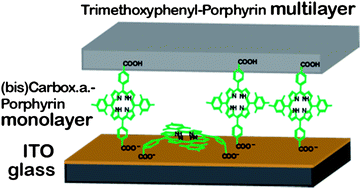Porphyrins have attracted much attention as dyes for photovoltaic applications due to their remarkable light harvesting properties and tunability of electronic behaviour. The photophysical and photochemical properties of porphyrins are influenced by electron-donating or electron-withdrawing substituents that can be attached at the perimeter of the porphyrin macrocycle. The current work shows that changing the porphyrin peripheral substituents can affect the direction of interfacial charge transfer at the interface of porphyrin and Indium tin oxide (ITO), a degenerate n-type semiconductor that is commonly used as a transparent conductive electrode in organic optoelectronic devices. Soret-band excitation resulted in electron injection from the molecular layer to the ITO in all porphyrin derivatives studied, suggesting that electron injection to ITO is faster than relaxation from the porphyrin upper excited state to the lower one. However, the direction of photo-induced electron transfer in the 500–650 nm spectral range (Q-bands excitation in porphyrins) was found to depend on the peripheral substituents. This is highly relevant for photovoltaic devices, as the solar spectrum peaks in this spectral range. The charge transfer behaviour was shown to depend on the composition of the interfacial adsorbed monolayer. Therefore, it is proposed that porphyrin derivatives can be used for modulating photo-induced interfacial transport at ITO/organic layer interfaces in a predefined, controllable way.

